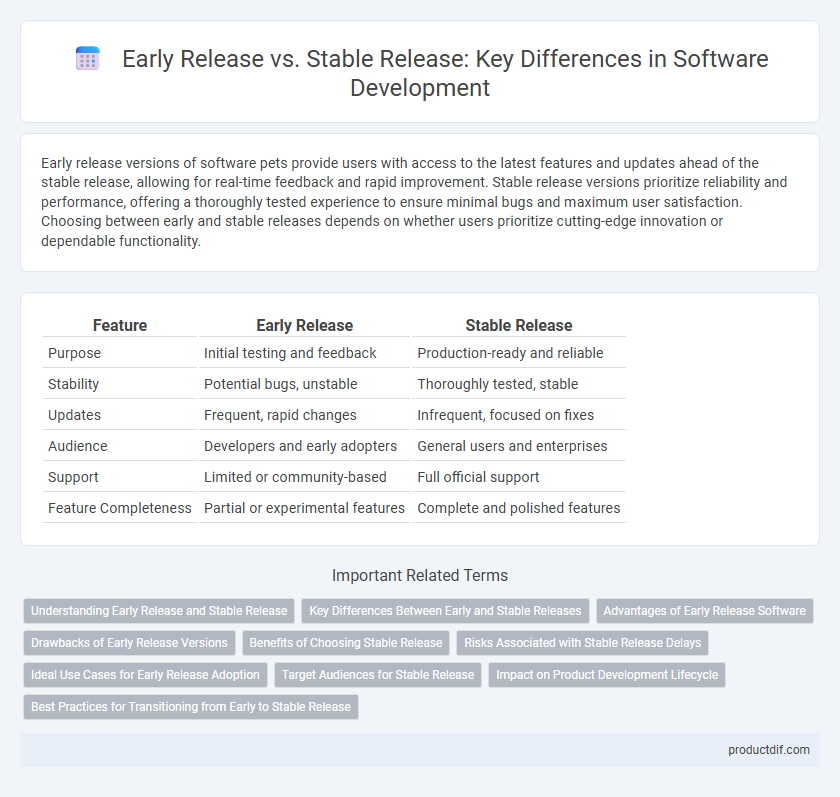Early release versions of software pets provide users with access to the latest features and updates ahead of the stable release, allowing for real-time feedback and rapid improvement. Stable release versions prioritize reliability and performance, offering a thoroughly tested experience to ensure minimal bugs and maximum user satisfaction. Choosing between early and stable releases depends on whether users prioritize cutting-edge innovation or dependable functionality.
Table of Comparison
| Feature | Early Release | Stable Release |
|---|---|---|
| Purpose | Initial testing and feedback | Production-ready and reliable |
| Stability | Potential bugs, unstable | Thoroughly tested, stable |
| Updates | Frequent, rapid changes | Infrequent, focused on fixes |
| Audience | Developers and early adopters | General users and enterprises |
| Support | Limited or community-based | Full official support |
| Feature Completeness | Partial or experimental features | Complete and polished features |
Understanding Early Release and Stable Release
Early release software versions provide users with access to new features and updates ahead of the official launch, helping developers gather real-world feedback and identify bugs. Stable releases undergo extensive testing and quality assurance to ensure reliability, performance, and security, making them suitable for broad deployment in production environments. Understanding the distinction between early release and stable release is crucial for managing risk and aligning software adoption strategies with organizational needs.
Key Differences Between Early and Stable Releases
Early releases often include experimental features and are primarily intended for testing and feedback, while stable releases undergo extensive quality assurance to ensure reliability and performance. Early releases may contain bugs and incomplete functionality, whereas stable releases provide a polished, production-ready experience suitable for end users. Deployment strategies differ, with early releases usually limited to developers or beta testers, and stable releases broadly distributed to the general user base.
Advantages of Early Release Software
Early release software offers rapid access to the latest features and improvements, enabling users to provide valuable feedback that drives iterative development. This approach facilitates early identification and resolution of bugs, resulting in more refined and reliable stable releases. Engaging with early versions enhances adaptability to software changes and accelerates innovation adoption within development cycles.
Drawbacks of Early Release Versions
Early release versions often contain unresolved bugs and incomplete features, leading to instability and frequent crashes. Users may experience compatibility issues with other software or hardware due to lack of thorough testing. Limited documentation and support can hinder effective troubleshooting and reduce overall user satisfaction.
Benefits of Choosing Stable Release
Stable releases ensure greater reliability and performance by undergoing extensive testing and debugging compared to early releases. They provide enhanced security with fewer vulnerabilities, reducing risks in production environments. Businesses benefit from consistent compatibility and official support, facilitating smoother integration and maintenance.
Risks Associated with Stable Release Delays
Delays in stable software releases increase the risk of prolonged exposure to security vulnerabilities and critical bugs present in early releases. Enterprises depending on stable updates may face operational inefficiencies and compatibility issues due to postponed access to essential feature improvements and performance optimizations. Extended wait times for stable releases can also hinder timely compliance with industry standards and slow down overall software lifecycle progression.
Ideal Use Cases for Early Release Adoption
Early release software versions are ideal for developers and tech enthusiasts seeking to test new features and provide feedback during the development cycle, enabling rapid innovation and continuous improvement. These releases suit environments where cutting-edge functionality is prioritized over complete stability, such as in beta testing, experimental projects, or when preparing for future production deployment. Organizations adopting early releases benefit from early access to enhancements and the ability to influence final software design through active participation.
Target Audiences for Stable Release
Stable releases target professional users, businesses, and production environments requiring reliable, thoroughly tested software with minimal bugs. These releases prioritize security, performance, and compatibility to ensure seamless integration into critical workflows and systems. Stability and long-term support attract enterprises seeking predictable updates and robust software maintenance.
Impact on Product Development Lifecycle
Early releases accelerate feedback loops by enabling developers to identify bugs and user experience issues sooner, which streamlines iterative improvements within the product development lifecycle. Stable releases prioritize reliability and performance, ensuring that final production environments operate with minimal risks and support long-term maintenance plans. Balancing early feedback incorporation with stable deployment schedules optimizes development efficiency and product quality.
Best Practices for Transitioning from Early to Stable Release
Transitioning from an early release to a stable release requires rigorous user feedback integration and extensive automated testing to ensure software reliability. Prioritizing bug fixes, performance optimizations, and thorough documentation enhances user confidence and reduces post-release issues. Establishing clear communication channels and version control strategies facilitates smooth updates and consistent user experiences throughout the transition.
Early release vs Stable release Infographic

 productdif.com
productdif.com